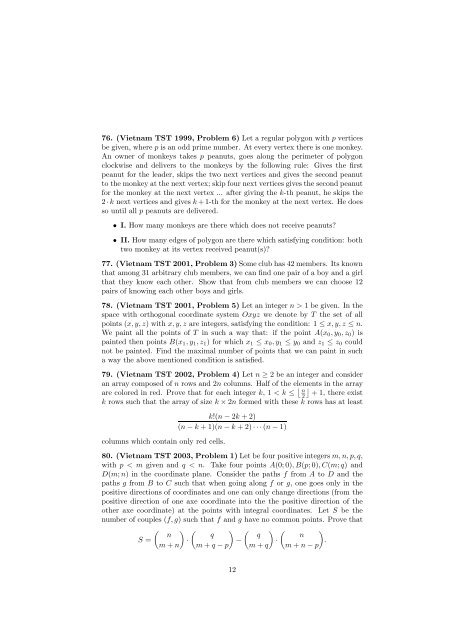Combinatorics Problems
Combinatorics Problems
Combinatorics Problems
Create successful ePaper yourself
Turn your PDF publications into a flip-book with our unique Google optimized e-Paper software.
76. (Vietnam TST 1999, Problem 6) Let a regular polygon with p vertices<br />
be given, where p is an odd prime number. At every vertex there is one monkey.<br />
An owner of monkeys takes p peanuts, goes along the perimeter of polygon<br />
clockwise and delivers to the monkeys by the following rule: Gives the first<br />
peanut for the leader, skips the two next vertices and gives the second peanut<br />
to the monkey at the next vertex; skip four next vertices gives the second peanut<br />
for the monkey at the next vertex ... after giving the k-th peanut, he skips the<br />
2 ·k next vertices and gives k +1-th for the monkey at the next vertex. He does<br />
so until all p peanuts are delivered.<br />
• I. How many monkeys are there which does not receive peanuts?<br />
• II. How many edges of polygon are there which satisfying condition: both<br />
two monkey at its vertex received peanut(s)?<br />
77. (Vietnam TST 2001, Problem 3) Some club has 42 members. Its known<br />
that among 31 arbitrary club members, we can find one pair of a boy and a girl<br />
that they know each other. Show that from club members we can choose 12<br />
pairs of knowing each other boys and girls.<br />
78. (Vietnam TST 2001, Problem 5) Let an integer n > 1 be given. In the<br />
space with orthogonal coordinate system Oxyz we denote by T the set of all<br />
points (x, y, z) with x, y, z are integers, satisfying the condition: 1 ≤ x, y, z ≤ n.<br />
We paint all the points of T in such a way that: if the point A(x 0 , y 0 , z 0 ) is<br />
painted then points B(x 1 , y 1 , z 1 ) for which x 1 ≤ x 0 , y 1 ≤ y 0 and z 1 ≤ z 0 could<br />
not be painted. Find the maximal number of points that we can paint in such<br />
a way the above mentioned condition is satisfied.<br />
79. (Vietnam TST 2002, Problem 4) Let n ≥ 2 be an integer and consider<br />
an array composed of n rows and 2n columns. Half of the elements in the array<br />
are colored in red. Prove that for each integer k, 1 < k ≤ ⌊ ⌋<br />
n<br />
2 + 1, there exist<br />
k rows such that the array of size k × 2n formed with these k rows has at least<br />
columns which contain only red cells.<br />
k!(n − 2k + 2)<br />
(n − k + 1)(n − k + 2) · · ·(n − 1)<br />
80. (Vietnam TST 2003, Problem 1) Let be four positive integers m, n, p, q,<br />
with p < m given and q < n. Take four points A(0; 0), B(p; 0), C(m; q) and<br />
D(m; n) in the coordinate plane. Consider the paths f from A to D and the<br />
paths g from B to C such that when going along f or g, one goes only in the<br />
positive directions of coordinates and one can only change directions (from the<br />
positive direction of one axe coordinate into the the positive direction of the<br />
other axe coordinate) at the points with integral coordinates. Let S be the<br />
number of couples (f, g) such that f and g have no common points. Prove that<br />
S =<br />
( ) n<br />
m + n<br />
(<br />
·<br />
q<br />
m + q − p<br />
)<br />
−<br />
( q<br />
m + q<br />
) (<br />
·<br />
n<br />
m + n − p<br />
)<br />
.<br />
12
















